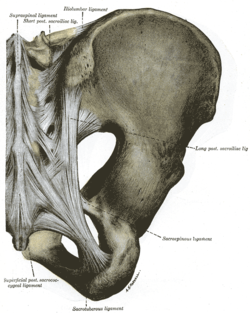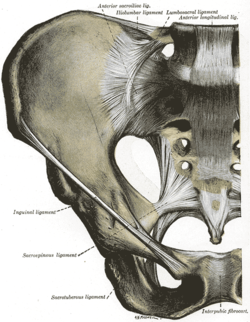Sacrococcygeal symphysis
| Sacrococcygeal symphysis | |
|---|---|

Articulations of pelvis. Posterior view.
|
|

Anterior view.
|
|
| Details | |
| Identifiers | |
| Latin | Articulatio sacrococcygea, symphysis sacrococcygea |
| Dorlands /Elsevier |
a_64/12161515 |
| TA | A03.2.08.001 |
| FMA | 16210 |
|
Anatomical terminology
[]
|
|
The sacrococcygeal symphysis (sacrococcygeal articulation, articulation of the sacrum and coccyx) is an amphiarthrodial joint, formed between the oval surface at the apex of the sacrum, and the base of the coccyx.
It is a slightly moveable joint which is frequently, partially or completely, obliterated in old age,homologous with the joints between the bodies of the vertebrae.
The sacrococcygeal disc or interosseus ligament is similar to the intervertebral discs but thinner, thicker in front and behind than at the sides, and with a firmer texture. The articular surfaces are elliptical with longer transversal axes. The surface on the sacrum is convex and that on the coccyx concave. Occasionally the coccyx is freely movable on the sacrum, most notably during pregnancy; in such cases a synovial membrane is present.
The joint is strengthened by a series of ligaments:
Movements in the joint are restricted to flexion and extension. These essentially passive movements occurs during defecation and labour. When movements in the sacrum increase the anteroposterior diameter of the pelvic outlet, movements in the sacrococcygeal joint can further increase this diameter.
The joint is palpable deep within the natal cleft, and can be felt as a horizontal groove. With the palpating finger on the dorsal surface of the coccyx, a degree of rotation can be produced with an applied forward pressure.
This article incorporates text in the public domain from the 20th edition of Gray's Anatomy (1918)
...
Wikipedia
